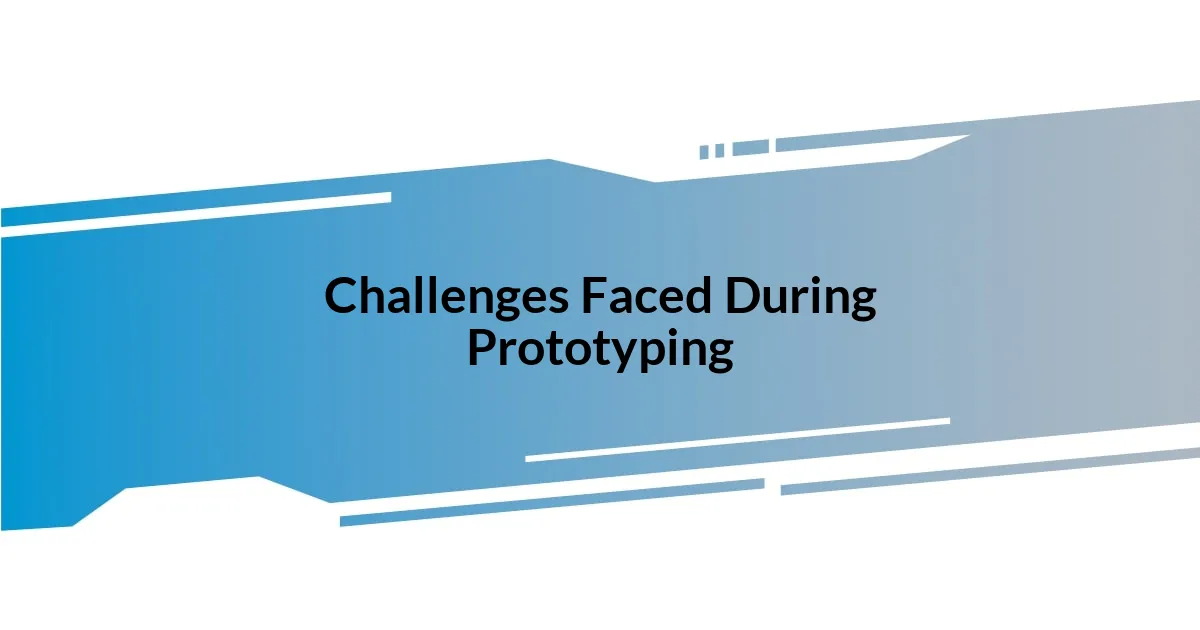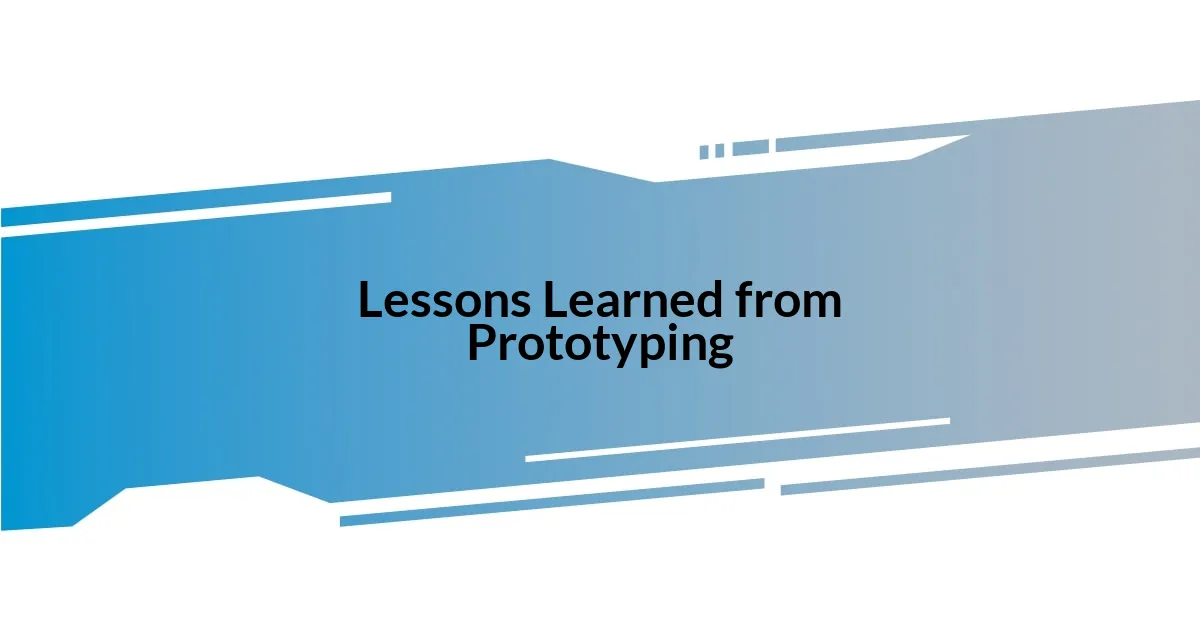Key takeaways:
- Rapid prototyping enhances creativity and innovation, allowing for multiple iterations and immediate feedback on product design.
- Collaboration and user feedback are crucial, as they transform abstract ideas into actionable, user-centered prototypes.
- Embracing flexibility and incremental improvements can significantly impact the development process, leading to better final products.
- Future advancements in rapid prototyping will likely integrate AI, eco-friendly materials, and virtual reality, streamlining design and enhancing user experience.

Introduction to Rapid Prototyping
Rapid prototyping is a game changer in product development, allowing ideas to transform into tangible forms in record time. I remember the first time I saw a rough sketch turn into a 3D-printed model overnight. That immediate transformation sparked a sense of excitement—how could an abstract idea suddenly take shape so quickly?
This process isn’t just about speed; it’s also about fostering creativity. Each iteration provides invaluable feedback, letting us learn and adapt. I often find myself wondering how many lofty dreams have been crushed because the traditional prototyping process was too slow or cumbersome. With rapid prototyping, we can explore multiple solutions in a fraction of the time, making it easier to hit that sweet spot between functionality and design.
Seeing my prototype evolve with every iteration is nothing short of exhilarating. The ability to quickly bring concepts to life encourages experimentation and innovation. Have you ever felt that rush of discovery when you realize a small change can lead to a significant improvement? It’s this personal journey through trial and error that makes rapid prototyping so impactful; each hurdle becomes a stepping stone toward a refined final product.

Importance of Rapid Prototyping
The importance of rapid prototyping cannot be overstated. When I think about the projects where I utilized this approach, one common theme emerges: clarity. Each prototype I created not only showcased my ideas but also highlighted what worked and what didn’t. This iterative process transformed vague concepts into clear, actionable steps, allowing my team and me to spot flaws before we invested resources into full-scale production.
- Accelerates the development timeline, allowing for faster go-to-market strategies.
- Enhances collaboration among team members, as visual prototypes facilitate clearer communication.
- Reduces expenses by identifying design issues early on, minimizing the risk of costly mistakes.
- Fosters innovation, encouraging teams to experiment without fear of failure.
- Provides immediate feedback, which can lead to improved user experience and functionality.
In reflecting on my experiences with rapid prototyping, I can’t help but feel grateful for the reduced anxiety it brings to the development phase. Shifting from an intangible idea to a concrete model is not just satisfying; it transforms the dream-like pursuit of innovation into a vibrant reality. With rapid prototyping, I found I could embrace the trial-and-error process, making each setback feel less like a failure and more like a stepping stone to success.

My First Rapid Prototyping Project
During my first rapid prototyping project, I was both excited and nervous. I had an idea for a user-friendly kitchen gadget that could simplify meal prep. With my sketches in hand, I dove straight into creating my initial 3D model. I remember the thrill of seeing it take shape, but the reality check hit when I realized the design was too bulky. That moment taught me the importance of adaptability—sometimes you need to step back and rethink your approach.
As I tweaked the design and printed successive iterations, I felt a sense of empowerment. The feedback loop created by rapid prototyping was engaging; each version brought me closer to functionality. I vividly recall the spark of insight I had after showing the third prototype to my family. Their enthusiastic reactions and constructive criticism made me reconsider features I hadn’t prioritized. This collaborative process highlighted how valuable external input can be, and it made the project feel less solitary and more like teamwork.
The biggest lesson from my first project was the emotional rollercoaster of innovation. From the initial rush of enthusiasm to the anxiety of potential failures, every step felt significant. I often asked myself how I could enhance not just the gadget, but the overall user experience. In reflecting on that early project, it’s clear that rapid prototyping isn’t just about building a product; it’s about discovering possibilities and embracing the journey with all its ups and downs.
| Aspect | Experience |
|---|---|
| Initial Idea | Kitchen gadget design |
| First Prototype | 3D model revealed design flaws |
| Feedback Iterations | Collaboration with family improved design |
| Emotional Journey | Excitement, anxiety, empowerment |

Tools for Rapid Prototyping
When it comes to tools for rapid prototyping, I’ve found a blend of software and hardware to be essential. For software, I leaned heavily on programs like Sketch and Figma for creating intuitive designs. They enabled me to visualize my ideas quickly and provided a platform for real-time collaboration with my team. Have you ever noticed how much a simple sketch can evolve when shared with others? That’s the power of these tools—they transform concepts into conversations.
On the hardware front, my go-to has been a 3D printer. The moment I fired it up for the first time was unforgettable. I was both excited and apprehensive, eagerly anticipating the first prototype’s reveal. When that model finally emerged, it was as if I had given life to my idea. I got to analyze the physical aspect of my design, which often revealed flaws that my screen couldn’t show. It’s fascinating how a tangible object can lead to insights a digital image might miss.
Incorporating user feedback tools, like usability testing kits, took my prototypes to another level. After gathering opinions from potential users, I often found myself pondering their responses long after the sessions ended. Would that feature be beneficial? Does the design resonate with them? These reflections helped refine my approach, blending emotional insight with technical adjustments. Rapid prototyping isn’t just about creating; it’s about connecting, understanding, and evolving based on that connection.

Challenges Faced During Prototyping
One of the most significant challenges I faced during prototyping was the unexpected complexity of turning a digital design into a physical product. I remember confidently printing what I thought was a flawless model, only to discover later that it didn’t fit the intended space in my kitchen. Have you ever had that moment where reality completely upends your expectations? It’s a humbling experience that forced me to reassess my understanding of scale and functionality.
Another hurdle was managing feedback effectively. While external opinions can be invaluable, I often found myself grappling with conflicting suggestions from different users. After one testing session, I was left with more questions than answers. Should I prioritize ease of use, or should I focus more on aesthetics? This internal conflict really highlighted the importance of knowing my target audience and aligning their needs with my vision, but it wasn’t always easy to navigate.
Time constraints posed yet another challenge that tested my planning skills. Rapid prototyping can feel like a sprint, and I often felt the pressure of deadlines creeping closer. I recall a moment when a prototype needed a major revision just days before a presentation. That frantic scramble to meet my goals taught me the value of time management and iterative design—having a cushion for unexpected issues is crucial, even in a fast-paced process.

Lessons Learned from Prototyping
One of the most profound lessons I learned from prototyping is the value of flexibility. I can vividly recall a project where I had meticulously planned every detail, only to realize halfway through that my original idea didn’t resonate with users. It was a big wake-up call! Embracing change, rather than resisting it, leads to more impactful outcomes. Have you ever found yourself attached to an idea, only to discover it might not be the best direction? Letting go can be liberating.
Another key takeaway has been the power of incremental improvements. I remember a prototype that went through countless iterations, each one teaching me something new. With every tweak, I would sit and assess what worked and what didn’t. Reflecting on that experience now, I realize that progress doesn’t always mean drastic changes; sometimes, the smallest adjustments lead to the biggest leaps forward. Isn’t it fascinating how patience and persistence during the process can yield surprising results?
Lastly, I learned the importance of storytelling in design. You wouldn’t believe how impactful it was when I started framing my prototypes as narratives. Each prototype I presented was not just a product; it became a story that connected emotionally with users. When I shared the journey behind the design, I noticed my audience’s engagement deepened. Have you ever considered how a compelling story can breathe life into your creations? This connection reminded me that we’re not just building objects; we’re crafting experiences that resonate on a human level.

Future of Rapid Prototyping
Looking ahead, I see rapid prototyping evolving significantly as technology advances. For instance, I’ve noticed a shift towards integrating AI and machine learning into the design process, which streamlines the idea-to-prototype transition. Imagine having an AI that analyzes user feedback in real time, allowing for immediate adjustments! It’s a game-changer that could potentially minimize the frustration of conflicting suggestions I often faced.
Additionally, I’m excited about the prospect of enhanced materials that will not only speed up production but also improve functionality. Recently, I read about new biocompatible materials that are being developed for 3D printing. From my experience, using eco-friendly, durable materials can transform the prototype into a prototype that’s sustainable and advantageous for users. Have you ever considered how the materials we choose can impact both design integrity and user experience?
Moreover, I believe that virtual reality (VR) will play a pivotal role in the future of prototyping. Imagine being able to “walk through” a digital prototype before it’s physically built! This could save a significant amount of time and resources. I once found myself wishing I could step into a design and experience it firsthand before committing to production. It’s thrilling to think that future designers might soon have such technology at their fingertips, empowering them to create even more effective and user-centered products.